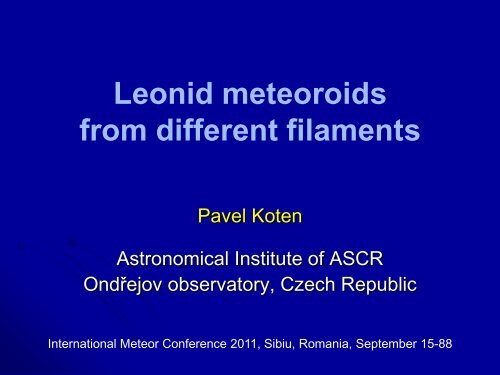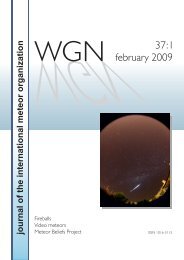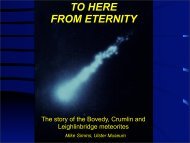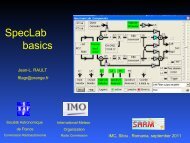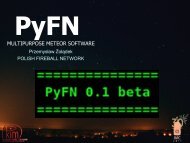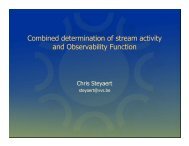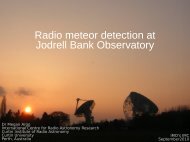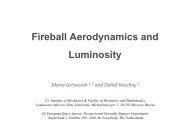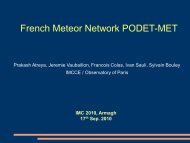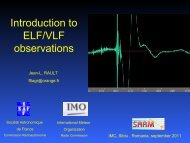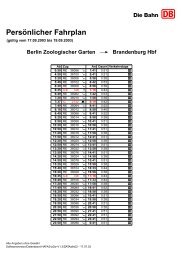Leonid meteoroids from different filaments - International Meteor ...
Leonid meteoroids from different filaments - International Meteor ...
Leonid meteoroids from different filaments - International Meteor ...
You also want an ePaper? Increase the reach of your titles
YUMPU automatically turns print PDFs into web optimized ePapers that Google loves.
<strong>Leonid</strong> <strong>meteoroids</strong><br />
<strong>from</strong> <strong>different</strong> <strong>filaments</strong><br />
Pavel Koten<br />
Astronomical Institute of ASCR<br />
Ondřejov observatory, Czech Republic<br />
<strong>International</strong> <strong>Meteor</strong> Conference 2011, Sibiu, Romania, September 15-88
Outline<br />
<strong>Leonid</strong>s in 1999-2009<br />
Observations, equipment, methods<br />
Beginning heights and properties of <strong>meteoroids</strong><br />
Results and comparison of <strong>different</strong> <strong>filaments</strong>
<strong>Leonid</strong>s between 1998 and 2009<br />
comet 55P/Tempel-Tuttle - perihelion 1998 February 28<br />
strong activity or storms in 1998 – 2002<br />
another enhanced activity 2006 and 2009<br />
<strong>different</strong> <strong>filaments</strong> of<br />
the stream, i.e. <strong>different</strong><br />
time of ejection <strong>from</strong><br />
parent comet<br />
(situation in 2001<br />
by D. Asher)
Individual <strong>filaments</strong><br />
Year 1998 1999 2000 2001 2002 2006 2009<br />
Date 17.11. 18.11 18.11<br />
.<br />
18.11. 19.11. 19.11. 17.11.<br />
Time<br />
1:29 2:13<br />
3:48<br />
10:06<br />
4:02<br />
4:45 21:44<br />
[UT]<br />
1:49<br />
7:57<br />
18:25<br />
10:48<br />
22:02<br />
17:59<br />
Year of<br />
ejection<br />
1333 1899<br />
1932<br />
1733<br />
1866<br />
1767<br />
1866<br />
1767<br />
1866<br />
1932 1466<br />
1533<br />
1699<br />
Note fireballs OK<br />
OK<br />
OK<br />
clouds<br />
OK<br />
OK<br />
OK<br />
-<br />
-<br />
-<br />
OK<br />
-<br />
Sources – Vaubaillon et al. (2005); McNaught and Asher (1999)
Our observations of <strong>Leonid</strong>s<br />
Year<br />
Filaments<br />
(age)<br />
1999 1899, 1932<br />
(3, 2)<br />
2000 1733<br />
(8)<br />
2001 1767<br />
(7)<br />
2006 1932<br />
(2)<br />
2009 1466, 1533<br />
(16, 14)<br />
Location Number of<br />
D-S <strong>Leonid</strong>s<br />
Spain 97<br />
Spain 54<br />
Arizona USA 362<br />
Czech<br />
27<br />
Republic, UK<br />
Tajikistan 56<br />
D-S means double-station (D SH , D’ criterions)
Instrumentation<br />
S-VHS video camera<br />
+ image intensifier<br />
Dedal-41 (till 2002)<br />
Mullard XX1332<br />
Arsat 50mm/F1.4:<br />
Ø FOV = 25º/44º<br />
MLM +5.0m<br />
spectral camera<br />
600 grooves/mm
Observation in Tajikistan 2009<br />
1) Gissar observatory<br />
λ = 68º 40’ 53.0’’<br />
φ = 38º 29’ 23.3’’<br />
2) Kurgan Tube – fireball<br />
network station<br />
λ = 68º 46’ 18.3’’<br />
φ = 37º 29’ 23.3’’<br />
southern station:<br />
- azimuth 356º<br />
- distance 111 km
Dust-ball model<br />
Hawkes & Jones (MNRAS, 1975):<br />
silicate or iron grains (3000 – 3500 K) + organic “glue” (~ 1300 K)<br />
radiation – only grains, not glue<br />
implications:<br />
Beginning height constant<br />
(for the same velocity meteors)<br />
Height of maximum light,<br />
terminal height – constant for<br />
smaller particles, decreasing<br />
for bigger masses<br />
of <strong>meteoroids</strong>
Beginning heights of <strong>different</strong><br />
showers<br />
Geminids – almost constant<br />
other showers – increasing HB<br />
GEM – just beginning of ablation<br />
and radiation<br />
others – actual beginning higher,<br />
observation at sensitivity limit<br />
More fragile <strong>meteoroids</strong> =<br />
= more steep curve<br />
(Koten et al., A&A, 2004)
Beginning heights in 2009<br />
<strong>Leonid</strong>s 2009:<br />
beginning heights:<br />
single and double station<br />
data<br />
single station – estimated<br />
trajectories, wide spread<br />
of height data<br />
=> useful for activity<br />
profile, mass index etc.
Distribution of beginning heights<br />
distribution of H B<br />
shows increase<br />
with mass<br />
2009:<br />
slope k = 6.5
Parameter K B<br />
One dimensional parameter – eliminates potential effect of<br />
<strong>different</strong> zenith distance of radiant (observations in <strong>different</strong><br />
countries )<br />
K<br />
B<br />
log(<br />
B<br />
)<br />
2.5log(<br />
v<br />
)<br />
0.5log cos( z<br />
R<br />
)<br />
Do we observe same effect for K B as for H B ?
K B vs. m phot<br />
<strong>Leonid</strong>s 2009:<br />
K B decreases with<br />
increasing mass<br />
observed among all<br />
studied <strong>filaments</strong><br />
not zenith distance<br />
of radiant effect
Comparison of <strong>different</strong> <strong>filaments</strong><br />
each line represents whole<br />
range of observed masses<br />
and beginning heights<br />
<strong>different</strong> <strong>Leonid</strong> <strong>filaments</strong> =<br />
<strong>different</strong> values of k<br />
(slope H B vs. M phot )<br />
(Geminids for comparison -<br />
almost mass independent)
Fragility vs. time <strong>from</strong> ejection<br />
higher k => more fragile<br />
particles (theoretical<br />
limit is 10)<br />
does it depend on age?<br />
idea:<br />
dust is more influenced<br />
by spaceweathering<br />
1466, 1533 – support idea
Conclusions<br />
• 10 years of <strong>Leonid</strong> outbursts and storms<br />
– samples of <strong>different</strong> age of <strong>meteoroids</strong><br />
• All <strong>filaments</strong> – more fragile material<br />
(according to H B in the atmosphere)<br />
• Small differences among <strong>filaments</strong><br />
• Suspicion – fragility dependence on age –<br />
cannot be clearly confirmed<br />
• Next work => search for possible reasons
Acknowledgement<br />
Thanks to all people who contributed individual <strong>Leonid</strong><br />
campaigns:<br />
- P. Spurný, J. Borovička, H. Betlem (management of<br />
campaigns)<br />
- A. Kolář, R. Štork, P. Trepka, A. Spurná, S. Evans, A.<br />
Elliott etc. (observations)<br />
Work supported by Grant Agency of Czech Republic,<br />
grant no. 205/09/1302.<br />
THANK YOU FOR YOUR ATTENTION!


